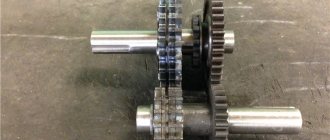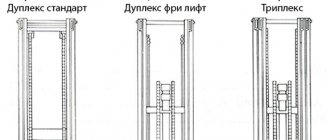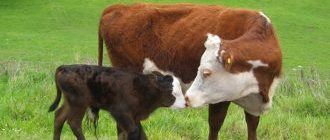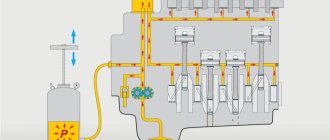Three-stroke milking machines
Devices of the first group operate according to the following scheme. During the first stroke (sucking), a vacuum is created in both chambers, interstitial and sub-mammary. The nipple is drawn into the glass and the milk is milked out. During the second stroke (compression), vacuum is given only to the nipple chamber, and atmospheric pressure is applied to the interwall chamber. The nipple contracts. On the third stroke (rest), there is no vacuum in both chambers, the nipple rests in its natural position, and blood circulation in it is restored. The time cycles are distributed as follows: 1st - 60%, 2nd - 10%, 3rd - 30%. 60 pulsations occur in 1 minute.
Push-pull milking machines
In a push-pull apparatus there is no rest, there is only sucking and squeezing. Here, 80 pulsations are carried out per minute. Push-pull devices are more productive.
However, they have a higher probability of the cow contracting mastitis if the glasses are not removed in a timely manner. Three-stroke models better match the natural suckling process of the calf. They more intensively stimulate milk production, promote milk production and increase animal productivity.
Milking units can be mobile or stationary. Collecting milk - in cans (buckets) or milk pipeline. With the first option, 1 operator serves 16 - 20 individuals, with the second - up to 50 or more. During milking, cows are located in stalls or pens. In the latter case, the process takes place in special halls or sites, possibly using robots. Depending on the number of cows in the pen, the installation can be individual or group. Machines are divided into movable (conveyors) and stationary; they can be located in different patterns: parallel, radial, sequential or at an angle. Domestic installations are equipped with the same milking machines, with the choice of the most suitable of several standard types and varying degrees of mechanization.
Milking time for one cow ranges from 4 to 6 minutes. The interval between milkings should be no less than 5 hours and no more than 12 hours.
A little history
Vintage Photo - Milking a Cow by Hand
Early attempts at milking cows involved a variety of methods. Around 380 BC, the Egyptians, along with traditional hand milking, attached a straw of wheat to the teat of cows. The milking machine was first used in 1851, although the attempt was not entirely successful.
To stimulate further invention, the Royal Agricultural Society of England offered a reward for the presentation of a safe milking machine.
At the end of the 19th century, a machine with a vacuum pump driven by a steam engine was developed in Scotland. This unit, along with the introduction of the double teat cup, led to automated milking of animals. Since the beginning of the 20th century, the principle of machine milking has taken root in the dairy industry.
Device structure
The classic milking machine has a simple device, which includes the following parts:
- body frame on wheels, making the device mobile (there are large units without wheels, but they are rare);
- a pump from which vacuum hoses come for supplying milk and air (the pressure in them can be measured using a vacuum gauge);
- a pulsator or manifold where the vacuum line ends (in some models there is no pulsator, and its role is played by a piston pump and valves that open and close in the direction of movement of the piston);
- 4 milking cups (according to the number of teats of the cow), the outer wall of which is metal (made of food steel or aluminum), and the inner wall is covered with rubber cuffs, one of which is connected to the nipple (internal) chamber for sucking milk, and the other to the chamber between walls to create vacuum pulsation;
- receiver for stabilizing vacuum in the line (not present in all models);
- milk and vacuum tubes coming out of the glasses and entering the manifold, on which there is a valve for supplying vacuum to the glasses;
- a milk line extending from the collector and leading to a common tank;
- can with a volume of 20 liters or more, which can be made of stainless steel, aluminum or plastic.
An aluminum tank is light and soft, so it can be damaged if accidentally tipped over, but a steel bucket is very heavy and inconvenient to use. Therefore, the best option is a plastic can with a transparent lid to make it easier to control the milk level in it.
Principle of operation
Milking machine: 1 – milking cups;
2 – collector; 3 – pulsator; 4 – milk pipeline; 5 – container for collecting milk. The functioning of the milking machine is based on the operation of a vacuum pump. A glass is attached to each teat of the cow.
When the device is connected to an electric current, milk is sucked out, which flows through glasses through hoses into a container for collecting it - a bucket or can.
The milk suction technology is as follows:
- A vacuum is created in the nipple chamber, in which there is always low pressure.
- A pulsator installed on the lid of the can emits vacuum pulses into the glasses. The presence of a pulsator allows you to control the supply of vacuum, making milking more comfortable for the cow.
- Under the pressure of vacuum pulsation, the nipple is compressed in the interwall chamber.
- When low pressure is created in these two chambers, milk flows first into the collector and then into the storage tank.
- The pressure in the interwall chamber rises to atmospheric pressure, parallel to which the rubber tube contracts and squeezes the nipple, and the milk stops flowing.
A similar operating principle is typical for push-pull milking machines, which perform 2 main functions - they compress the nipple and pump out milk.
There are also three-stroke devices, the difference of which is that they suck milk from each nipple in turn, squeezing them in order.
Between suction cycles, short breaks are taken to restore blood supply to the mammary glands, thanks to which the cow quickly gets used to the device.
In a three-stroke machine, 50 pulsations occur per minute, and in a two-stroke machine - 90.
The operating principle of two- and three-stroke devices is presented in the diagram:
Specifications
Models 1P and 2P are characterized by the presence of similar parameters:
- total productivity – from 8 to 10 heads per hour;
- The engine is powered from a 220 volt network;
- motor power 550 W;
- pressure in the system – from 40 to 50 kPa;
- pulsation occurs at a frequency of 64 cycles per minute;
- milk container capacity is 22.6 liters;
- weight without packaging of model 1P is 45 kg, model 2P is 47 kg.
The manufacturer provides a 1-year warranty. The contents of each model may vary.
Kinds
Milking machines may differ both in technical characteristics and in the method of operation. Let's consider the popular criteria for their classification in more detail.
By motor and pump type
A cow milking machine can be equipped with the following engine:
Oily
Its advantage is its quiet operation, which significantly increases the cow's comfort level during milking.
The disadvantages of an oil engine include:
- sensitivity to low temperatures (problems with starting are possible);
- the need for constant maintenance (you will have to regularly add fluid and monitor the oil level to avoid leaks).
In winter, the oil can harden, making it difficult to start the machine.
Dry action
More unpretentious engines, however, they have a significant drawback - they make a lot of noise during operation. To cope with it, you will have to install mufflers.
Dry engines are also sensitive to air humidity, under the influence of which they quickly overheat.
When operating and storing dry-type devices, do not allow any liquid to get inside the structure.
The pump in the milking machine is also of three types:
- Membrane . The cheapest option and designed for minimal loads – milking up to 3 heads at a time. Suitable for small farms only.
- Piston . Compared to membrane ones, it is more productive, but during operation it makes a lot of noise and quickly overheats. Units with a piston pump have large dimensions.
- Rotary . A reliable dry or oil pump that takes up little space and does not make any loud noises during operation.
By type of milking
Paired apparatus
Based on the method of milking and connecting the glasses to the nipples, the apparatus can be of two types:
- Simultaneous (regular) . The glasses are attached to 4 milking breasts, so the device simultaneously sucks milk from all nipples.
- Pairwise (asynchronous) . In such models, glasses are installed in pairs. Milking is carried out using 2 glasses. They are put on the nipples one by one. This is the most gentle regime for the animal.
Devices with a paired milking method allow you to quickly accustom a cow to machine milking, and also completely eliminate problems with the udder.
By purpose of application
Milking parlor with an industrial apparatus
Machines for milking cows are conventionally divided into two types:
- Household . Selected mainly for small households. Such devices have a simple design and are equipped with removable parts that can be replaced with new ones after wear.
- Industrial . Such units are produced for industry and are designed for milking a large number of cows. They are powerful and involve several automatic operating systems, the choice of which is made depending on which cattle need to be milked.
Review of popular models
Milking machines are presented on the market in a wide variety, but among them the following models are especially popular:
AID-1
The device is based on a push-pull operating principle and without a pulsator. Convenient for small farms, since it can serve no more than 10 cows in 1 hour.
It has an oil pump that does not overheat and does not make much noise during operation. The pressure is 47 kPa, that is, close to the optimal 50 kPa.
AID DA-3M "Volga"
A three-stroke universal machine that has two-chamber stainless steel teat cups and is also equipped with a pulsator, a vacuum valve and a main hose.
Doyushka 1R
Compact in size, automated and reliable. Suitable for small farms - it can milk about 10 cows in 1 hour. The farmer does not need to adjust the number of cycles. The pulsation depends on the operation of the piston pump, which creates 64-70 strokes per minute.
Maiga
Two-stroke and easy to maintain unit. A bucket with a handle is attached to the device, so it is very convenient to drain the milk. It is characterized by high mobility.
My Milka
Dry rotor type units. Equipped with a powerful engine capable of 1450 revolutions. The set includes 4 glasses for pair milking. The models are designed to serve 8 cows in 1 hour.
Berezka-1, Berezka-2
Mobile dry type installations. They can milk up to 24 cows in 30 minutes. Equipped with a powerful motor that makes loud noises. Power – 1500 rpm.
Compact (1 STD, 2 STD) from Milkline
Popular dry type devices from a leading European manufacturer. One mobile unit can process up to 14 cows in 1 hour. The milk comes into a transparent bucket with a measuring ruler.
DeLaval
Units with a dry-type electric motor from a Swedish manufacturer. They do not make noise during operation. They are considered one of the best, but have a high cost.
Buryonka
The lightest unit in weight, which differs from other models in the separate location of the milking bucket. Farmers recommend choosing Burenka Tandem equipment for simultaneous double milking.
Units are also produced in “Standard”, “Euro”, “Stainless Steel”, “Maxi” modifications. Up to 20 heads can be served in 1 hour. Power - from 1500 to 3000 rpm.
Milk pipeline
For large farms with more than 50 cows, the most profitable option is milking machines with a milk pipeline, which allow not only to increase production, but also to save on rather expensive milking equipment. One of the most popular milk pipelines on the Russian market is Siberia.
Milking equipment is manufactured for the simultaneous milking of 50 to 400 cows while being kept tied in a barn. The standard package includes:
- Supply glass pipe or stainless steel pipe,
- Impact resistant pipes,
- Three-cycle machine for paired milking,
- Vacuum water installation with a tank of one hundred liters,
- A tank of fifty liters for the initial reception of milk,
- Vacuum valve between pipes and milk receiver.
The purpose of the milk pipeline is not only milking, but also transportation of milk to a special department of the plant, measurement of one-time milk yield from a cow, filtration, pumping of the already filtered product into a container for temporary storage.
Tips for choosing a device
When purchasing a milking machine, you should consider a number of recommendations:
- If you have a large number of cows, it is better to choose a three-stroke milking unit. If there are 2 cows on the farm, a push-pull machine is sufficient.
- To milk cows at the grazing site, choose a more mobile and lighter-weight unit. It is advisable that the bucket or can for collecting milk be installed directly on the unit, otherwise there will be difficulties in moving it.
- If cows are in stalls, it is better to purchase a stationary device with which you can milk several animals at once.
When buying a device in a store, you need to check its operation, adjustment and fastening of all parts.
Milking machines
The installation is a set of milking equipment, which includes a vacuum pump with an electric drive, a vacuum cylinder (receiver), a regulator, pipelines and a milking machine, one, two or more. There are also washing systems and units for primary processing of the resulting raw materials. The operation of all industrial and domestic installations is based on the use of vacuum. The vacuum is created using a diaphragm, rotary, centrifugal or piston type pump. The pulsator serves to direct the vacuum at the right time to the appropriate chambers of the glasses, thereby ensuring alternation of strokes.
How to milk a cow with a machine?
The technology of machine milking a cow is simple, but requires compliance with the correct procedure and a number of rules:
- Before milking, check the serviceability of the equipment , especially the operation of the pulsator, collector and vacuum unit.
- Examine the cow. If there is mastitis on the udder and teats, milk her by hand. Transfer the cow to machine milking only after complete recovery.
- An hour before milking, clean the stalls and wash the udders with warm water or a special solution. Do not use cold or hot liquid as this will slow down milk flow. Behave calmly around a cow, without raising your voice.
- After treatment, wipe the teats dry using individual wipes and massage them in a circular motion, slightly pushing up individual parts of the udder, repeating the actions of the calf when feeding.
- Manually milk a small portion of milk and check that there are no blood clots, lymph inclusions, etc. During this time, the animal’s milk ejection reflex is activated.
- First open the vacuum valve of the machine and immediately after preparing the udder, put on the milking cups. To do this, take the collector with one hand from below and bring it to the udder, and with the other hand, alternately put the glasses on the nipples, starting with the rear ones.
- Only after milking has started do you move on to the next cow. If milk flow slows down or stops, massage the cow's udder until the process resumes. There is no need to tear off the equipment.
- If the teat cups fall off, turn off the machine , rinse the cups with clean water, massage the udder and start milking again. The machine itself should be placed closer to the cow's front hooves to make it more difficult to tip over.
- After milking, remove the glasses. To do this, take the manifold or milk tubes with one hand and squeeze them, and with the other, close the tap on the manifold or the clamp on the hose. Next, squeeze the rubber suction cup of the glass to release the air, and at the same time, smoothly remove all the glasses. Connect the collector to a vacuum and suck out the remaining milk in the glasses.
- Finally, wipe the nipples with a dry towel and lubricate them with Vaseline or an antiseptic emulsion.
- Clean the milking machine using a vacuum. First, pass warm water (32-35°C) through it, and then a disinfectant. From time to time, it is advisable to disassemble the device into parts and wash off the resulting deposits. Store the machine in a specially designated place.
If after milking with a machine there is milk left in the udder, milk the cow manually so that she does not develop mastitis.
The scheme for using the milking machine looks like this:
Variety of milking machines
They select a machine for the farm based on its parameters:
- the place where the container for collecting dairy products is located;
- how the milking process occurs;
- whether there is an interruption or not.
Dairy products are obtained thanks to the vacuum created by the machine. Low-vacuum equipment causes less damage to the cow's udder, and therefore it is advisable to use it for young animals. But for an adult, it is best to choose a high-vacuum machine.
Milking itself can be either continuous or with temporary intervals. Machines of the first type are used for adult animals for which milking is a common procedure. In young animals, milk is obtained using two-stroke or three-stroke milking machines.
For individual use, mini-milking machines designed for 1 to 2 heads have become very popular. Such devices are used for animals of any size, and the unit is also easy to move from one place to another.
Milking plant structure
How to make it yourself at home?
If you have ready-made components and some available materials, you can assemble the unit yourself. We will consider the sequence of actions below.
Preparation of components
To assemble the milking machine, you need to prepare the following components:
- electric motor to ensure pump operation;
- pump - oil, dry or vacuum;
- a belt that ensures rotation from the pump to the engine;
- vacuum hoses for pumping air;
- a vacuum cylinder that smoothes out fluctuations arising from air pressure (in factory designs, this function is performed by a receiver);
- exhaust pipe for removing air to the outside;
- dielectric insert, which prevents voltage from spreading throughout the device;
- vacuum gauge (to control the pressure created, milking is carried out only when the indicator is at around 50 kPa);
- glasses, a collector and a pulsator are components of the hinged part of the device, which must be purchased at a specialized store;
- milk hoses made of silicone;
- container for collecting milk (can or bucket);
- vacuum regulator for pressure correction;
- air valve for releasing air into the can.
Assembly
The assembly of the suspension unit is of great importance. It is carried out in this order:
- Connect the milk line ring to the lower end of the rubber intended for nipples. The distance between them is at least 5 mm.
- Insert the thin end of the milk pipe into the rubber, pull it through it and place it in the milking glass.
- Place the rubber head on top of the glass. It is imperative to ensure that the tension is even, because all this affects the speed of milking.
- Place the vacuum pipe on the side pipe located on the body.
After assembly, rinse the system, which will also allow you to check the tightness of the connections. To do this, pour hot water into a bucket, immerse the milking cups in it and turn on the machine. Rinse for 5 minutes. After this, the glasses can be placed on the teats and the cow can be milked for about 6 minutes.
Once a month, it is recommended to disassemble the device into parts and rinse each of them thoroughly in hot water.
Troubleshooting
After self-assembly of the milking machine, there are some malfunctions that require timely elimination:
- Insufficient vacuum pressure due to extraneous air intake . Most likely, the reason lies in the poor tightness of the suspension unit. This problem can also be encountered when the glasses are incorrectly attached to the milkings.
- Extraneous sounds are made . If the device makes strange sounds during operation, this indicates poor fastening of the connecting elements.
- The motor is slipping . The problem may be caused by a loose belt or oil getting on it.
Terms of use
The milking unit must be maintained daily. What does care include?
- Do not leave even a minimal amount of milk in the appliance.
- After use, the entire system should be thoroughly cleaned. Milk is an excellent environment for the development of pathogens. The device can be washed with clean running water.
- Once every seven days, the tubes are washed with brushes and the outer part with a dry rag to remove dust and external contaminants.
Advantages and disadvantages
The milking machine has a number of advantages compared to manual milking:
- Increases farm productivity. A milking unit greatly increases the speed of milking: in half an hour an experienced milkmaid can milk 2-3 cows, and a good machine can milk about 10-20.
- Protects milk from contact with hands and air, so it turns out fresh, without foreign odors;
- Requires a minimum of time and effort;
- Does not harm the health of the cow.
The main disadvantage of such a device is its high cost. However, such costs quickly pay off with good volumes of milk.











